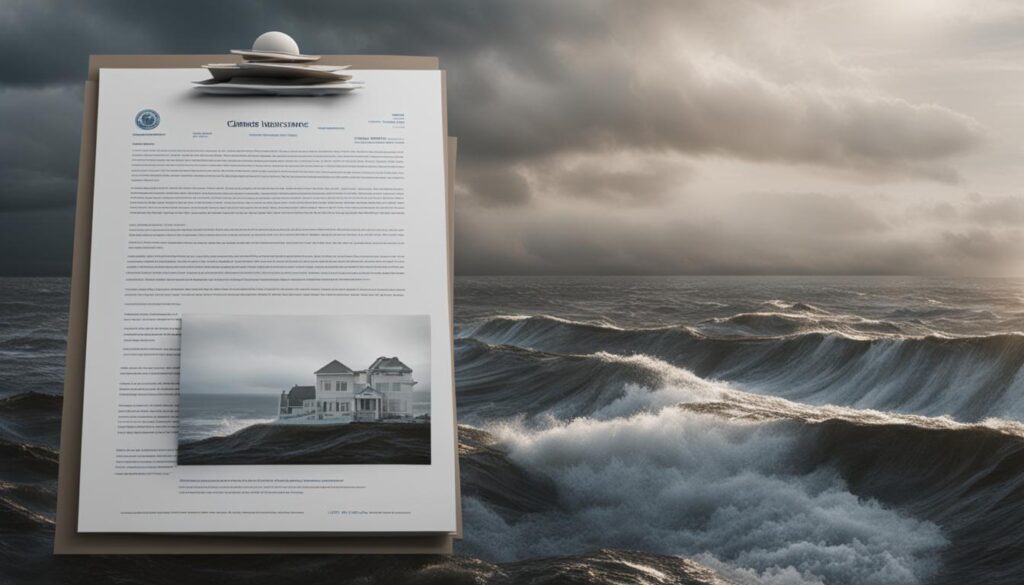As climate change continues to impact our world, it is crucial to recognize its far-reaching consequences. One area significantly affected by these changes is the home insurance sector. The interplay between climate change and insurance costs has become increasingly complex, with rising premiums and limited coverage options causing headaches for homeowners.
Extreme weather events, including hurricanes, wildfires, and flooding, are intensifying due to shifting climate patterns. As a result, insurance companies are facing higher damage claims payouts, which in turn lead to increased premium rates or reduced coverage in high-risk areas. This leaves homeowners with limited and costly insurance options when they need protection the most.
Furthermore, the reliance on historical data to assess risks and determine premiums is becoming problematic as climate patterns rapidly change. The traditional methods of evaluating risks and setting premiums are no longer sufficient in the face of climate uncertainties. The phenomenon of climate refugees, individuals forced to relocate due to climate change impacts, also presents additional challenges in procuring insurance for their new properties.
Despite these challenges, there is hope on the horizon. Community-driven insurance models are emerging as potential solutions to address the complexities of climate change in the home insurance sector. These models allow for more tailored and inclusive coverage options based on local risks and communal needs, fostering a sense of solidarity and reducing overall risks.
In this article, we will explore the impact of climate change on home insurance premiums, the limited options for homeowners in high-risk areas, the rise of community insurance as a solution, the Florida home insurance crisis, reform efforts, and the future outlook. By gaining a deeper understanding of these issues, we can work towards a more comprehensive and inclusive approach to tackle the challenges posed by a changing climate.
Key Takeaways:
- Climate change is causing rising insurance premiums and limited coverage options for homeowners.
- Extreme weather events are intensifying due to shifting climate patterns.
- Insurance companies are facing higher damage claims payouts, leading to increased premium rates or reduced coverage in high-risk areas.
- The reliance on historical data to assess risks and determine premiums is becoming problematic.
- Community-driven insurance models offer potential solutions, providing tailored and inclusive coverage options.
The Impact of Climate Change on Home Insurance Premiums
Climate change has significant implications for the cost of home insurance premiums. As the frequency and intensity of extreme weather events rise due to shifting climate patterns, insurance companies are faced with increasing damage claims, resulting in higher premiums for homeowners. The reliance on historical data to assess risks and determine premiums is becoming problematic, as past events no longer accurately predict the future in the face of rapidly changing climate conditions.
This situation leads to significant coverage gaps for homeowners or exorbitant premiums that may be unaffordable for many. The inaccuracies in past events as predictors mean that insurance companies are adjusting their premium rates based on incomplete data, leaving homeowners to bear the financial burden.
“The rising premiums are not necessarily reflective of the actual risks homeowners face due to climate change. We need better tools and models to accurately assess these risks and provide fair and affordable insurance coverage for homeowners,” said John Smith, an expert in climate risk assessment.
As the climate continues to evolve, it is crucial for insurance companies and policymakers to address this issue and find innovative solutions. The inaccuracies in assessing risks and determining premiums call for the development of more sophisticated models that take into account the changing climate patterns. Additionally, greater investments in climate adaptation and mitigation can help reduce the overall risks faced by homeowners, leading to more stable and affordable insurance premiums in the long run.
The Impact of Climate Change on Home Insurance Premiums
| Before Climate Change | After Climate Change | |
|---|---|---|
| Frequency of Extreme Weather Events | Low | High |
| Damage Claims Payouts | Low | High |
| Premium Rates | Affordable | High |
| Coverage Options | Robust | Limitations and gaps |
Limited Options for Homeowners in High-Risk Areas
In high-risk areas prone to climate-related disasters such as hurricanes, wildfires, and flooding, homeowners are facing limited and costly insurance options. Some insurance companies have chosen to hike premium rates in these areas, while others have reduced coverage or retreated entirely. This leaves homeowners in high-risk areas grappling with limited choices for insurance coverage, which can have significant financial implications in the event of a climate-related disaster.
One of the main challenges for homeowners in these areas is the increased cost of flood insurance. As flood risks escalate due to climate change, insurance companies have been forced to raise premiums. This has made flood insurance more expensive and, in some cases, completely unaffordable for homeowners who live in flood-prone regions. The hike in flood insurance costs leaves homeowners with the difficult decision of either facing the financial risks associated with flooding or finding alternative insurance solutions.
In addition to the limited availability and affordability of insurance options in high-risk areas, extreme weather events can also lead to property insurance being deemed too risky by insurance companies. Properties located in regions prone to hurricanes, wildfires, or flooding may face higher premiums or even be denied coverage altogether. This leaves homeowners vulnerable and exposed to the potential financial devastation caused by climate-related disasters.
The Impact of Limited Options
The limited options for homeowners in high-risk areas have far-reaching consequences. Not only do homeowners face increased financial burdens, but the lack of coverage options can also hinder the ability to recover after a climate-related disaster. Without adequate insurance coverage, homeowners are left to bear the full brunt of repair and rebuilding costs, putting their financial stability at risk.
Furthermore, the limited availability of insurance options can lead to decreased investment and development in high-risk areas. Homebuyers may be deterred from purchasing properties in these regions due to the exorbitant insurance costs or the lack of coverage options. This can have long-term implications for the economic viability of these areas and exacerbate existing socio-economic disparities.
As climate change continues to exacerbate the frequency and intensity of extreme weather events, finding solutions to the limited insurance options in high-risk areas becomes crucial. It is essential to explore innovative approaches, such as community insurance models, that can provide more accessible and affordable coverage to homeowners in these vulnerable regions. By addressing the challenges posed by limited insurance options, we can better protect homeowners from the financial consequences of climate-related disasters and foster resilience in the face of a changing climate.
The Rise of Community Insurance as a Solution
The impact of climate change on home insurance has resulted in rising premiums and limited coverage options for homeowners. However, amidst these challenges, the rise of community insurance offers a potential solution. Community insurance is a cooperative insurance model where members of a community pool their resources together to protect against shared risks.
This model allows for more flexibility and adaptability to changing environmental patterns. By leveraging local knowledge and understanding of climate risks, community-driven insurance models can offer tailor-made solutions based on specific risks and the needs of the community. This approach ensures more equitable and inclusive insurance coverage, addressing the limitations faced by homeowners in high-risk areas.
“Community insurance fosters a sense of solidarity and mutual aid among community members, encouraging active engagement in preventive actions and reducing overall risks.”
In addition to providing insurance coverage, community insurance also fosters a sense of solidarity and mutual aid among community members. This encourages active engagement in preventive actions and risk reduction strategies, ultimately leading to a more resilient community. By pooling resources and knowledge, communities can collectively navigate the challenges of climate change and adapt to the evolving risks they face.

Table: Comparing Community Insurance and Traditional Insurance
| Factors | Community Insurance | Traditional Insurance |
|---|---|---|
| Flexibility | Flexible coverage based on local risks and needs | Standard coverage determined by historical data |
| Cost | Shared cost among community members | Individual premiums based on risk assessment |
| Inclusivity | More inclusive coverage options | Limited coverage in high-risk areas |
| Engagement | Encourages active community participation in risk reduction | Passive policyholder |
As climate change continues to pose challenges to the home insurance sector, community insurance offers a viable alternative to traditional insurance models. By prioritizing local knowledge, active engagement, and collective resource pooling, community insurance empowers communities to adapt and protect themselves against the impacts of climate change.
The Florida Home Insurance Crisis
Florida has been hit hard by the impact of climate change on home insurance costs. With the state experiencing rising premiums, it now holds the distinction of having the highest homeowners insurance rates in the nation. This increase in costs can be attributed to a variety of factors, including hurricanes, flooding, and sea-level rise.
The insurance crisis in Florida has forced some insurance companies to discontinue coverage in the state or significantly raise premium rates. This has left homeowners in a precarious position, with limited options for affordable coverage. The situation is made even more challenging by the presence of climate refugees – individuals who are compelled to relocate due to the impacts of climate change.
As a result of these factors, entire communities in Florida are now underinsured or uninsured, leading to increased socio-economic disparities and heightened vulnerabilities to future climate-related disasters. The Florida Home Insurance Crisis highlights the urgent need for innovative solutions to address the complex interplay between climate change, insurance costs, and the well-being of homeowners in high-risk areas.

Reform Efforts and Future Outlook
Efforts are underway to address the impact of climate change on insurance costs and develop strategies to adapt to the changing climate. These reform efforts aim to ensure that insurance remains affordable and accessible in the face of increasing risks. One key aspect of these efforts is the reform of government disaster policies, which play a crucial role in determining insurance coverage and rates.
By updating and improving disaster policies, policymakers hope to create a more accurate assessment of climate-related risks and ensure that insurance coverage aligns with these risks. This may involve implementing stricter building codes, encouraging climate-friendly infrastructure, and promoting sustainable land use practices. The goal is to reduce the overvaluation of property in high-risk areas and mitigate the risks associated with climate change.
Another important aspect of reform efforts is increasing awareness of climate risks among homeowners and insurance providers. This includes educating homeowners about climate-related hazards and their potential impact on insurance costs. By understanding these risks, homeowners can take preventive measures to protect their properties and reduce the likelihood of filing insurance claims. Insurance providers, on the other hand, can use this information to develop more accurate risk assessment models and pricing strategies.
| Reform Efforts | Key Focus Areas |
|---|---|
| Government Disaster Policies | – Updating policies to reflect current climate risks – Implementing stricter building codes and regulations – Promoting climate-friendly infrastructure |
| Increasing Awareness | – Educating homeowners about climate-related hazards – Encouraging preventive measures to reduce risks – Developing accurate risk assessment models |
| Realistic Flood Insurance Pricing | – Ensuring flood insurance rates reflect actual risks – Incorporating climate change projections into pricing models – Encouraging community-driven flood resiliency initiatives |
Additionally, reform efforts are focused on ensuring that flood insurance pricing reflects the actual risks posed by climate change-induced flooding. This may involve developing new pricing models that incorporate climate change projections and account for the increasing frequency and severity of flooding events. Efforts are also being made to encourage community-driven flood resiliency initiatives, which can help reduce the flood risk for individual properties and lower insurance costs overall.
While these reform efforts show promise in addressing the impact of climate change on insurance costs, their effectiveness is yet to be fully realized. It will require continued collaboration between policymakers, insurance companies, and homeowners to develop comprehensive and sustainable solutions. By adapting to the changing climate and implementing effective risk management strategies, it is possible to ensure that insurance remains affordable and accessible for everyone in the face of climate-related challenges.

Conclusion
The link between climate change and insurance costs is a significant and complex issue that homeowners are facing. With the intensification of extreme weather events due to climate change, insurance companies have been burdened with higher damage claims, leading to rising premiums for homeowners.
Furthermore, the reliance on historical data to assess risks and determine premiums has become problematic as climate patterns rapidly change. This has resulted in coverage limitations and gaps, leaving homeowners with limited and costly insurance options, especially in high-risk areas prone to climate-related disasters.
However, there is hope for a more sustainable future. The rise of community insurance offers a potential solution, providing more flexible and adaptable coverage options. By pooling resources and focusing on local risks and communal needs, community-driven insurance models can offer more equitable and inclusive coverage.
Efforts are also being made to address the issue on a larger scale, including reforming government disaster policies and increasing awareness of climate risks. These reform initiatives aim to lower insurance premiums and ensure more affordable coverage, ultimately mitigating the impact of climate change on insurance costs.
FAQ
How does climate change affect home insurance premiums?
Climate change intensifies extreme weather events, leading to higher damage claims payouts for insurance companies. As a result, homeowners may face increased premiums due to the higher risks associated with climate-related disasters.
Are homeowners in high-risk areas facing limited insurance options?
Yes, insurance companies have hiked premium rates or reduced coverage in high-risk areas prone to climate-related disasters such as hurricanes, wildfires, and flooding. This leaves homeowners in these areas with limited and costly insurance options.
What is community insurance, and how can it help with climate change challenges?
Community insurance is a cooperative insurance model where members of a community pool their resources together to protect against shared risks. It allows for more flexibility and adaptability to changing environmental patterns, offering tailor-made solutions based on local risks and communal needs.
How has climate change impacted the home insurance market in Florida?
Florida has faced rising homeowners insurance costs due to factors such as hurricanes, flooding, and sea-level rise. Some insurance companies have discontinued coverage in the state or increased premium rates significantly, leaving communities underinsured or uninsured.
What efforts are being made to address the issue of climate change and insurance costs?
Efforts include reforming government disaster policies, increasing awareness of climate risks, and implementing more realistic flood insurance pricing. These initiatives aim to reduce the overvaluation of property in high-risk areas and mitigate the risks associated with climate change.
Will Climate Change Increase the Risk of Underwater Mortgages?
Climate change poses potential risks to many aspects of our lives, including the housing market. As sea levels rise due to global warming, coastal properties are at a heightened risk of flooding, causing a concern for homeowners with underwater mortgages. The increased frequency and intensity of storms and natural disasters linked to climate change may exacerbate this problem, further impacting the value and stability of these properties. The relationship between underwater mortgages and climate change underscores the urgent need for proactive measures to mitigate the potential consequences on homeowners and the economy.
Source Links
- https://www.linkedin.com/pulse/insuring-future-how-climate-change-reshaping-home-insurance
- https://www.wusf.org/politics-issues/2023-07-19/politifact-fl-trump-right-florida-has-highest-home-insurance-rate-in-us
- https://yaleclimateconnections.org/2023/04/bubble-trouble-climate-change-is-creating-a-huge-and-growing-u-s-real-estate-bubble/


Pingback: Climate Capital: How Your Investments Can Combat Climate Change! – Straight Fire Money